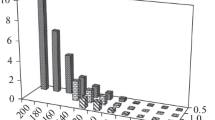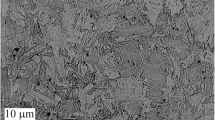Conclusions
-
1.
The method of testing the steel at a low strain rate gives reproducible results and makes it possible to rank correctly the inhibitors on the basis of the protective effect in a 15% NaCl solution, saturated with hydrogen sulfide and CO2, at 100°C.
-
2.
Of the examined components of the solution, corresponding to the minearlized working medium, the most negative effect on the resistance to sulfide cracking both at 25°C and at 100°C, is exerted by hydrogen sulfide, with the effect of CO2 being also appreciable; addition of sodium chloride increases the resistance of APIX46 steel in comparison with its resistance in distilled water.
-
3.
In this solution, the maximum protective effect of APIX46 steel is shown by the Neftekhim-3 inhibitor at all examined concentrations (100–1000 mg/liter). The protective effect of the Kaspii-2 inhibitor was detected only at concentrations higher than 400 mg/ liter. A Travis 1100 V inhibitor can also be used efficiently at these concentrations.
-
4.
In the chloride solution saturated with hydrogen sulfide and CO2 at 100°C SM90SSU steel is not susceptible to sulfide cracking at a concentration of Neftekhim-3 inhibitor higher than 100 mg/liter. However, the concentration of Kaspii-2 and Travis 1100 V inhibitors should be higher than 200 mg/liter.
-
5.
In the standard NACE solution at 25°C the protective effect is exerted by all inhibitors in the concentrations reaching 1400–2000 mg/liter. The efficiency decreases in the sequence: Kaspii-2 > Neftekhim-3 > Travis 1100 V.
-
6.
To obtain reliable data on protective effect of the inhibitors in the service conditions it is necessary to develop a method of autoclave tests of specimens at a low strain rate. In this case, it is useful to ensure that the parameters (pressure and temperature) are similar to those in industry, and the main components determining the corrosion-mechanical strength of metals should also be considered.
-
7.
While the imported Travis 1100 V inhibitor efficiently protects the steel in the service conditions, the Soviet inhibitors Neftekhim-3 and Kaspii-2 at the appropriate concentration (see paragraphs 3, 4) are superior to the imported inhibitor.
Similar content being viewed by others
Literature cited
J. C. Turn, B. E. Wilde, and C. A. Troiano, “On the sulfide stress cracking of line pipe steels,” Corrosion,39, No. 9, 364–370 (1983).
L. S. Saakiyan and A. P. Efremov, Protection of Oil and Gas Equipment Against Corrosions [in Russian], Nedra, Moscow (1982).
V. Yamambe, K. Motoda, H. Kurahashi, et al., “Stress corrosion cracking behavior for low alloy steels in H2S environments,” Kawasaki Steel Liho.,17, 178–184 (1985).
A Method of Determining the Degree of Protection of Steels Against Corrosion-Mechanical Failure by Inhibitors in Hydrogen Sulfide-Bearing Minearalized Media. Guiding Instructions [in Russian], All-Union Scientific Research and Design Institute of Oil, Ufa (1988).
V. M. Kushnarenko, G. V. Kemkhadze, E. A. Rumyamtseva, and V. S. Ukhanov, “Evaluation of the efficiency of inhibitors of hydrogen sulfide corrosion of steels,” Zashch. Met., No. 5, 867–870 (1988).
M. Margot, G. Bardou, and I. C. Charbonier, “The application of the slow strain rate test method for the development of line pipe steels resistant to sulfide stress cracking,” Corrosion Sci.,27, No. 10/11, 1009–1026 (1987).
A. Ikeda, T. Kanena, and Y. Ando, “On the evaluation method of sulfide stress cracking susceptibility of carbon and low alloy steels,” Corrosion Sci.,27, No. 10/11, 1099–1115 (1987).
M. D. Getmanskii, E. Kh. Enikeev, Yu. G. Rozhdestvenskii, et al., Corrosion and Protection of Oil Plant and Pipelines in Media with a High Content of Hydrogen Sulfide and CO2 [in Russian], All-Union Scientific Research Institute of Organization of Economics in Oil and Gas Industry, Moscow (1984).
G. Herbsleb, R. K. Poepperling, and W. Shwenk, “Occurrence and prevention of hydrogen induced stepwise cracking and stress corrosion cracking of low alloy pipe line steels,” Corrosion,37, No. 5 247–250 (1981).
NACE, Standard MR-01-85 (1980 Revision). Sulfide Cracking Resistant Metallic Materials for Oilfield Equipment NACE, Houston, Texas (1980).
I. I. Vasilenko and R. K. Melekhov, Corrosion Cracking of Steels [in Russian], Naukova Dumka, Kiev (1977).
R. L. Martin, “Hydrogen penetration and damage to oil field steels,” Mater. Perform, 13, No. 7, 19–23 (1974).
V. Hluchan, L. Pelikan, and I. Vosta, “Corrosion and SCC of steel in H2S environments,” in: Proc. 9th Intern. Congr. On Metallic Corrosion, Vol. 3, Toronto (1984), pp. 538–542.
Author information
Authors and Affiliations
Additional information
Translated from Fiziko-Khimicheskaya Mekhanika Materialov, Vol. 27, No. 4, pp. 25–33, July–August, 1991.
Rights and permissions
About this article
Cite this article
Enikeev, E.K., Getmanskii, M.D., Melekhov, R.K. et al. Evaluation of the protective effect of inhibitors of corrosion, hydrogen charging, and sulfide cracking of line pipe steels. Mater Sci 27, 353–360 (1992). https://doi.org/10.1007/BF00723224
Received:
Issue Date:
DOI: https://doi.org/10.1007/BF00723224




